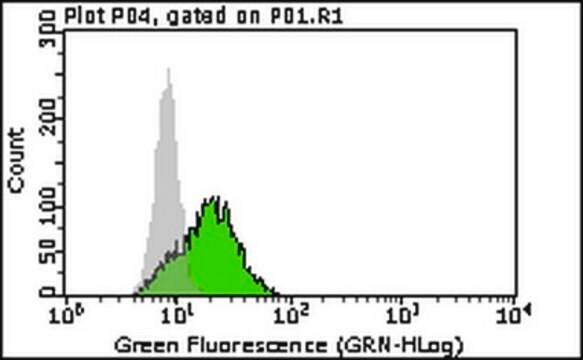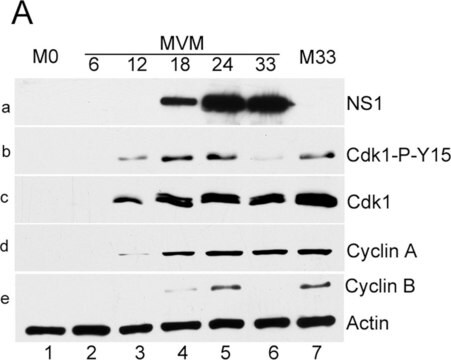MABE1078
Anti-TAF10/TAFII30 Antibody, clone 23TA-1H8
ascites fluid, clone 23TA-1H8, from mouse
Synonym(s):
Transcription initiation factor TFIID subunit 10, STAF28, TAF(II)30, TAFII-30, TAFII30, Transcription initiation factor TFIID 30 kDa subunit
About This Item
Recommended Products
biological source
mouse
Quality Level
antibody form
ascites fluid
antibody product type
primary antibodies
clone
23TA-1H8, monoclonal
species reactivity
human
should not react with
mouse
technique(s)
ChIP: suitable
immunocytochemistry: suitable
immunoprecipitation (IP): suitable
western blot: suitable
isotype
IgG1κ
NCBI accession no.
UniProt accession no.
shipped in
dry ice
target post-translational modification
unmodified
Gene Information
human ... TAF10(6881)
General description
Specificity
Immunogen
Application
Western Blotting Analysis: A representative lot detected TAF10 (TAFII30) in HeLa nuclear extracts as well as in SPT20-containing SAGA immune complex, but not in ADA2a-containing ATAC immune complex (Nagy, Z, et al. (2010). Cell. Mol. Life Sci. 67(4):611-628).
Western Blotting Analysis: Representative lots detected the presence of TAF10 (TAFII30) in TAFII30-containing complexes immunoprecipitated from HeLa nuclear extracts (Nagy, Z., et al. (2009). Mol .Cell. Biol. 29(6):1649-1660; Wieczorek, E., et al. (1998). Nature. 393(6681):187-191).
Immunoprecipitation Analysis: Representative lots immunoprecipitated TAF10- (TAFII30-) containing complexes from HeLa nuclear extracts (Nagy, Z., et al. (2009). Mol .Cell. Biol. 29(6):1649-1660; Wieczorek, E., et al. (1998). Nature. 393(6681):187-191).
Epigenetics & Nuclear Function
Transcription Factors
Quality
Western Blotting Analysis: A 1:1,000 dilution of this antibody detected TAF10/TAFII30 in 10 µg of A431 cell lysate.
Target description
Physical form
Storage and Stability
Handling Recommendations: Upon receipt and prior to removing the cap, centrifuge the vial and gently mix the solution. Aliquot into microcentrifuge tubes and store at -20°C. Avoid repeated freeze/thaw cycles, which may damage IgG and affect product performance.
Other Notes
Disclaimer
Not finding the right product?
Try our Product Selector Tool.
Storage Class Code
12 - Non Combustible Liquids
WGK
WGK 1
Flash Point(F)
Not applicable
Flash Point(C)
Not applicable
Regulatory Listings
Regulatory Listings are mainly provided for chemical products. Only limited information can be provided here for non-chemical products. No entry means none of the components are listed. It is the user’s obligation to ensure the safe and legal use of the product.
JAN Code
MABE1078:
Certificates of Analysis (COA)
Search for Certificates of Analysis (COA) by entering the products Lot/Batch Number. Lot and Batch Numbers can be found on a product’s label following the words ‘Lot’ or ‘Batch’.
Already Own This Product?
Find documentation for the products that you have recently purchased in the Document Library.
Our team of scientists has experience in all areas of research including Life Science, Material Science, Chemical Synthesis, Chromatography, Analytical and many others.
Contact Technical Service








